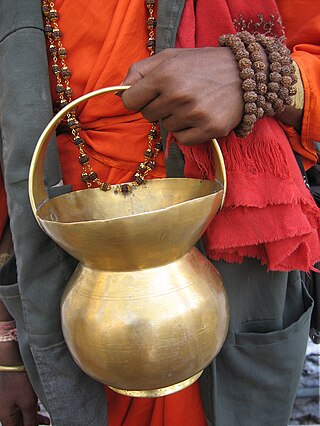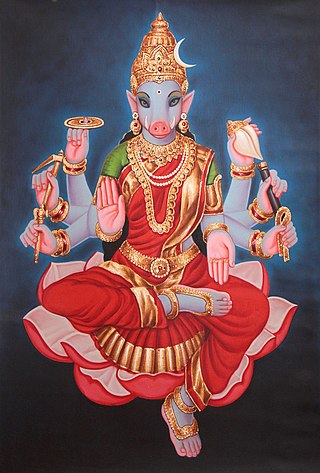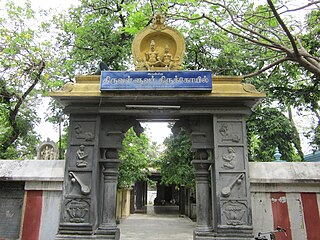
The Kapaleeshwarar Temple is a Hindu temple dedicated to the god Shiva located in Mylapore, Chennai in the Indian state of Tamil Nadu. The temple was built around the 7th century CE and is an example of South Indian Architecture.

Uthamar Kovil in Uthamarkoil, a village in the outskirts of Tiruchirappalli in the South Indian state of Tamil Nadu, is dedicated to the Hindu Trimurti of Vishnu, Shiva, and Brahma. Constructed in the Dravidian style of architecture, the temple is glorified in the Nalayira Divya Prabandham, the early medieval Tamil canon of the Alvar saints from the 6th–9th centuries CE. It is one of the 108 Divya Desams dedicated to Vishnu, who is worshipped as Purushothaman Perumal and his consort Lakshmi as Poornavalli Thayar.

Shukra is a Sanskrit word that means "clear" or "bright". It also has other meanings, such as the name of a sage who was the preceptor of the asuras and taught them the Vedas. In medieval mythology and Hindu astrology, the word refers to the planet Venus, one of the Navagrahas.
Matrikas (Sanskrit: मातृका (singular), IAST: mātṝkā, lit. "mothers") also called Matar or Matri, are a group of mother goddesses who are always depicted together in Hinduism. The Matrikas are often depicted in a group of seven, the Saptamatrika(s) (Seven Mothers). However, they are also depicted as a group of eight, the Ashtamatrika(s). In the Brihat Samhita, Varahamihira says that "Mothers are to be made with cognizance of (different major Hindu) gods corresponding to their names." They are associated with these gods as their spouses or their energies (Shaktis). Brahmani emerged from Brahma, Vaishnavi from Vishnu, Maheshvari from Shiva, Indrani from Indra, Kaumari from Kartikeya, Varahi from Varaha and Chamunda from Chandi. and additionals are Narasimhi from Narasimha and Vinayaki from Ganesha.

Thrikkakara Vamanamoorthy Temple is one of the major Hindu temples in India dedicated to Vamana, a form of the god Vishnu. It is situated in Thrikkakara, Kochi in the state of Kerala, India. The temple is around two millennia old and is also listed as one of the 108 Divya Desams.

Kamandalu, kamandal, or kamandalam is an oblong water pot, originating from the Indian subcontinent, made of a dry gourd (pumpkin) or coconut shell, metal, wood of the Kamandalataru tree, or from clay, usually with a handle and sometimes with a spout. Hindu ascetics or yogis often use it for storing drinking water. The water-filled kamandalu, which is invariably carried by ascetics, is stated to represent a simple and self-contained life.

Varahi is one of the Matrikas, a group of seven mother goddesses in the Hindu religion who bears the head of a sow. In Nepal, she is called Barahi. In Rajasthan and Gujarat, she is venerated as Dandini.

Ulagalandha Perumal Temple is a temple dedicated to Vishnu located in Kanchipuram, Tamil Nadu, India. Constructed in the Dravidian style of architecture, the temple is glorified in the Naalayira Divya Prabandham, the early medieval Tamil canon of the Alvar saints from the 6th through 9th centuries CE. It is one of the 108 Divya Desams dedicated to Vishnu, who is worshipped as Ulagalantha Perumal, and his consort Lakshmi as Amuthavalli. The temple is believed to have been built by the Pallavas, with later contributions from the medieval Cholas, Vijayanagara kings, and Madurai Nayaks.

Kazheesirama Vinnagaram or Tadalan Kovil or Tiruvikrama (trivikara) Perumal Temple is a temple dedicated to Vishnu located in Sirkazhi, Tamil Nadu, India. Constructed in the Dravidian style of architecture, the temple is glorified in the Nalayira Divya Prabandham, the early medieval Tamil canon of the Alvar saints from the 6th–9th centuries CE. It is one of the 108 Divya Desam dedicated to Vishnu, who is worshipped as Trivikrama and his consort Lakshmi as Loganayagi. The temple is believed to have been built by Cholas, with later contributions from Medieval Cholas, Vijayanagara kings, and Madurai Nayaks.

Ulagalantha Perumal Temple or Trivikrama Temple is a Hindu temple dedicated to Vishnu located in Tirukkoyilur, Tamil Nadu, India. Constructed in the Dravidian style of architecture, the temple is glorified in the Naalayira Divya Prabandham, the early medieval Tamil canon of the Alvar saints from the 6th–9th centuries CE. It is one of the 108 Divya Desams dedicated to Vishnu, who is worshipped as Ulagalantha Perumal and his consort Lakshmi as Poongothai. The temple is believed to have been built by the Medieval Cholas, with later contributions from Vijayanagara kings and Madurai Nayaks. The temple covers an area of 5 acres (20,000 m2) and has a temple tower that is the third tallest in Tamil Nadu, measuring 192 ft (59 m) in height.

The Ekambareswarar–Kamakshi Temple, commonly known as the Thiruvalluvar Temple, is a Hindu temple dedicated to the poet-saint Valluvar in the neighborhood of Mylapore in Chennai, India. The shrine is located within the Ekambareswarar temple complex. Believed to have been constructed in the early 16th century, the temple was extensively renovated in the 1970s. Traditionally believed to be the birthplace of Saint Valluvar, the temple is the oldest ever built to Valluvar. The temple also serves as the venue for meetings of Tamil language enthusiasts and conducting Kural classes. While many consider the temple as the birthplace of Valluvar, some additionally consider it as his samadhi.

Karaneeswarar Temple is a Hindu temple located in the neighborhood of Saidapet in Chennai, India. It is dedicated to Shiva. This is an ancient Temple presently managed by the HR & CE department of the Government of Tamil Nadu. The Goddess is known as "Swarnambika". Apart from this, there are separate shrines for Lord Ganapathi, Lord Karthikeya and other Parivara Devtas. This temple is located next to the Saidapet Railway station.

The Karaneeswarar Temple is a 12th-century Hindu temple in the neighbourhood of Mylapore in Chennai, India. The temple is dedicated to Shiva as Karaneeswarar. There are also shrines to Sarvamangala Vinayaka (Ganesha), Dandapani (Kartikeya), Durga, Lakshmi and Saraswati.

The Mangadu Kamakshi Amman Temple is a famous pilgrim destination Hindu temple dedicated to goddess Parvathi, located in Mangadu, a suburb of Chennai, India. The term Mangadu means "Mango Forests or Mango Groves" and as the term implies this must have been a thickly wooded Mango groove in times of yore.
Velleeswarar Temple is a Shiva temple located in Mangadu, a suburb of Chennai, India. This is a mid-size temple spread over 2 acres and is among the 3 principal temples in Mangadu – the other 2 being the Sri Kamakshi Amman Temple and Sri Vaikunda Perumal Temple. The temple is managed by the HRCE Department of the Government of Tamil Nadu. It is situated about 2 kilometers from Sri Kamakshi Amman Temple in Mangadu.

Vamaneeswarar Temple is a Hindu temple dedicated to the deity Shiva, located in Thirumanikuzhi, a village in Cuddalore district in the South Indian state of Tamil Nadu. Shiva is worshiped as Vamaneeswarar, and is represented by the lingam. His consort Parvati is depicted as Manonmani Amman. The temple is located on the Chennai - Villupuram highway on the banks of Kedilam river. The presiding deity is revered in the 7th century Tamil Saiva canonical work, the Tevaram, written by Tamil saint poets known as the nayanmars and classified as Paadal Petra Sthalam.

Tirttapaleeswarar Temple is a Hindu temple located in Triplicane in Chennai, India. It is dedicated to Shiva as Tirttapaleeswarar.

Virupakshiswarar Temple is a Hindu temple located in Mylapore in Chennai, India. It is dedicated to Shiva.

Valeeswarar Temple is a Hindu temple located in Mylapore in Chennai, India. It is dedicated to Shiva.

Malleeswarar Temple is a Hindu temple located in Mylapore in Chennai, India. It is dedicated to Shiva.


















